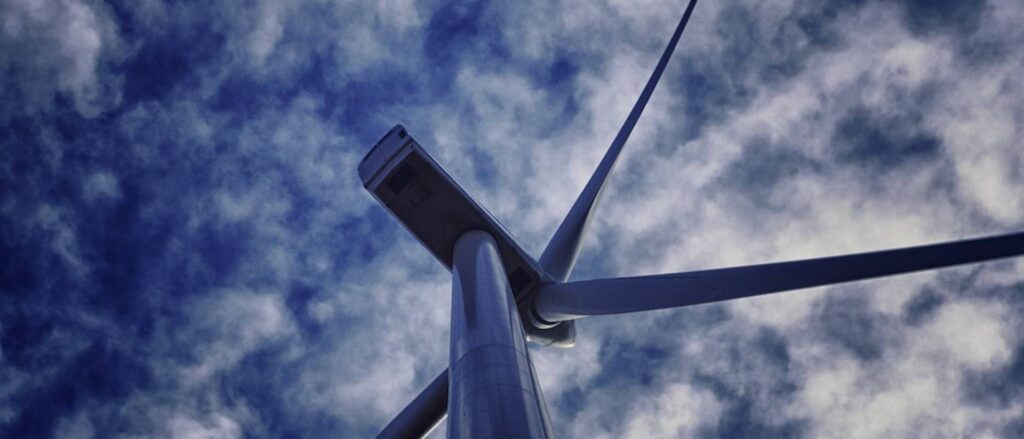
This wind turbine was installed near Hobbs, New Mexico, in 2012 as part of a compressed-air energy demonstration project. (Photo by Peter Root..)
Three University of Wisconsin System schools collaborated on a study to identify ways for state manufacturers to develop more products for green-energy technologies.
A report released last month, “Advancing Wisconsin’s Green Manufacturing Economy,” is the result of a yearlong study undertaken by faculty, staff members and undergraduate researchers at UW-Eau Claire, UW Oshkosh and UW-Milwaukee.
The project, funded by the Tommy G. Thompson Center on Public Leadership, identifies “significant untapped manufacturing capacity” for state industries.
“The coming years have the potential to be an exciting time for Wisconsin’s manufacturing economy,” says Dr. Matthew Jewell, a UW-Eau Claire associate professor of materials science and engineering, and the principal investigator on the project. “We are all well aware of the headwinds for manufacturing brought on by globalization, automation, changing customer needs and now a global pandemic. But there are also real opportunities for manufacturers to adapt to new markets, and with some coordination between the private and public sectors, we can ensure that Wisconsin remains a manufacturing leader for years to come.”
Researchers evaluated market conditions and opportunities for Wisconsin manufacturers to further develop products and processes to become involved in the green-energy sector. They identified specific research and development opportunities to leverage existing capacity and capabilities to meet the current development requirements of the wind, solar and biogas industries, as well as energy-storage technologies such as lithium-based batteries.
Jewell collaborated on the study with UW-Eau Claire faculty members Dr. Thomas Kemp, professor and chair of the economics department; Dr. Yan Li, associate professor of economics; as well as Dr. Kevin Crawford, director of UW Oshkosh’s Sustainability Institute for Regional Transformation; Brian Langolf, UW Oshkosh biogas program director; and Dr. Junjie Niu, associate professor of engineering at UW-Milwaukee.
Ten UW-Eau Claire undergraduate researchers and a UW-Milwaukee graduate student collaborated on the study as well.
Jewell and his UW-Eau Claire research group worked to identify research and development opportunities in the wind energy and solar energy industries. Kemp and Li collaborated on the economic analysis, including identifying current capabilities of the manufacturing sectors, aligning those sectors with “advanced energy” manufacturing needs and doing comparisons between Wisconsin and neighboring states.
Niu and his research group worked on lithium ion battery manufacture analysis, including the marketing potential, challenges and opportunities in Wisconsin.
“Most of the lithium batteries are imported from only a few Asian countries,” says Niu, who was a co-principal investigator on the project. “However, there is ample opportunity for state manufacturers to join in the supply chain, which would reduce costs and make Wisconsin a player in the production of next-generation lithium ion batteries. And that matches the long-term goal of the state becoming a leader in energy storage.”
With strong agriculture and dairy industries, UW-Oshkosh’s Crawford and Langolf say energy production from biogas is a clear continued growth industry for Wisconsin. They identified policy challenges and opportunities for development that could expand the biogas sector in Wisconsin.
“A more robust regulatory framework and targeted investment in technical challenges would allow Wisconsin to establish its national leadership in this area and become a net ‘exporter’ of biogas technology to neighboring states,” Langolf says.
The report identifies specific businesses that could be aligned with manufacturers of green-energy products. The report will be distributed to about 200 Wisconsin manufacturers.
Researchers say the next step is to reach out to those businesses to determine how product transitions could be made, identify potential obstacles and better align state incentives to the process.
The report identifies policy recommendations for the state and UW System officials to create an environment for manufacturers to more easily transition to the green-energy fields.
Top photo caption: This wind turbine was installed near Hobbs, New Mexico, in 2012 as part of a compressed-air energy demonstration project. (Photo by Peter Root. View full photo credit.)
